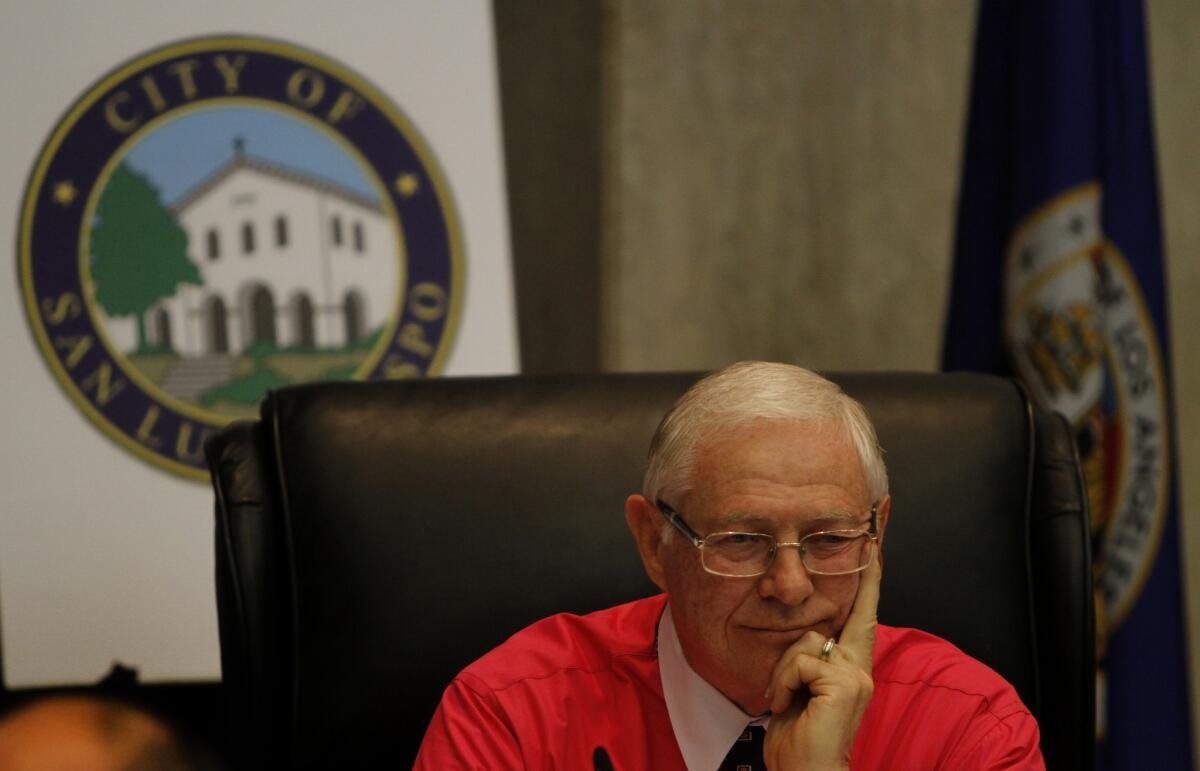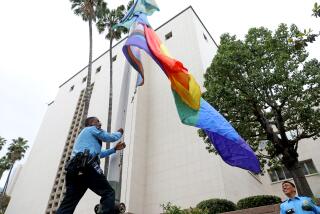Lawyers state their case in suit over Christian cross on L.A. County seal

Michael Antonovich, a member of the Los Angeles County Board of Supervisors, is seen during discussions in January 2014 of whether to add a cross to the top of the San Gabriel Mission depiction on the county seal. Antonovich was a proponent of adding the cross.
Lawyers made their final arguments Thursday in a federal lawsuit over Los Angeles County’s use of a Christian cross on the county seal -- but they left court without a clear sign of which side would come out on top.
The Board of Supervisors decided last year in a divided vote to place the cross on top of a depiction of the San Gabriel Mission, which appears among other symbols of county history.
The supervisors were promptly sued by a group of religious leaders and scholars from different faiths, represented by the American Civil Liberties Union of Southern California and a private law firm. The plaintiffs argued that placing the cross on the seal was unconstitutional because it endorsed Christianity over other religions.
Supporters of the cross argued that missions are a part of California’s history and that adding the cross to the official seal was intended to make it historically accurate, not to promote Christianity.
The supervisors had voted 10 years earlier to remove a cross from the seal after being threatened with a similar suit. The cross at that time was shown floating above the Hollywood Bowl.
The new seal created in 2004 showed the facade of the mission without a cross. At the time, the real mission’s cross was also missing. It was taken down during retrofitting after the Whittier Narrows earthquake and later stolen. The cross was eventually recovered and was placed back atop the mission in 2009.
The two conservatives on the board, Michael D. Antonovich and Don Knabe, opposed the removal of the original cross and were eventually joined by Supervisor Mark Ridley-Thomas in voting to place a cross on the seal again.
The stated reason for the change was to make the seal more historically and architecturally accurate, but the plaintiffs pointed to emails sent by Antonovich and Knabe to constituents and staff that suggested otherwise.
The lawsuit filings quoted an email from Antonovich that referred to opponents of the cross as “Storm Troopers [who] want to rewrite History – From Book burning to Church burning.” In others, he called the Los Angeles Times “Secular Extremest [sic]” for an editorial that opposed the reinstatement of a cross on the seal and urged one of his supporters to purchase the newspaper because, if not, “liberals will continue in attacking God, Family, and freedom.”
Timothy T. Coates, an attorney with the firm Greines, Martin, Stein & Richland LLP, which represented the county, argued that the supervisors’ emails were beside the point and the real question was what a “reasonable observer” who saw the county seal would think.
He argued that Californians grow up learning about the historical significance of missions and would not see a picture of a mission with a cross on top as an endorsement of religion.
“The way Californians experience missions, the way they’re taught in school is in a secular fashion,” he told U.S. District Judge Christina A. Snyder. “Californians are conditioned to view missions as historic structures.”
Attorney Linda M. Burrow, with the firm Caldwell Leslie & Proctor, which represented the plaintiffs along with the ACLU, disputed the “assumption that because a portion of history that has a religious aspect is taught in a school, that that makes it secular.”
“When you teach, you educate. When you put something on the seal, you promote,” she said. “It has the effect of advancing religion, and it was intended to do just that.”
Snyder did not say when she would rule on the case but told the lawyers, “I don’t think it’s a clear issue one way or the other.”
Twitter: @sewella
More to Read
Sign up for Essential California
The most important California stories and recommendations in your inbox every morning.
You may occasionally receive promotional content from the Los Angeles Times.











